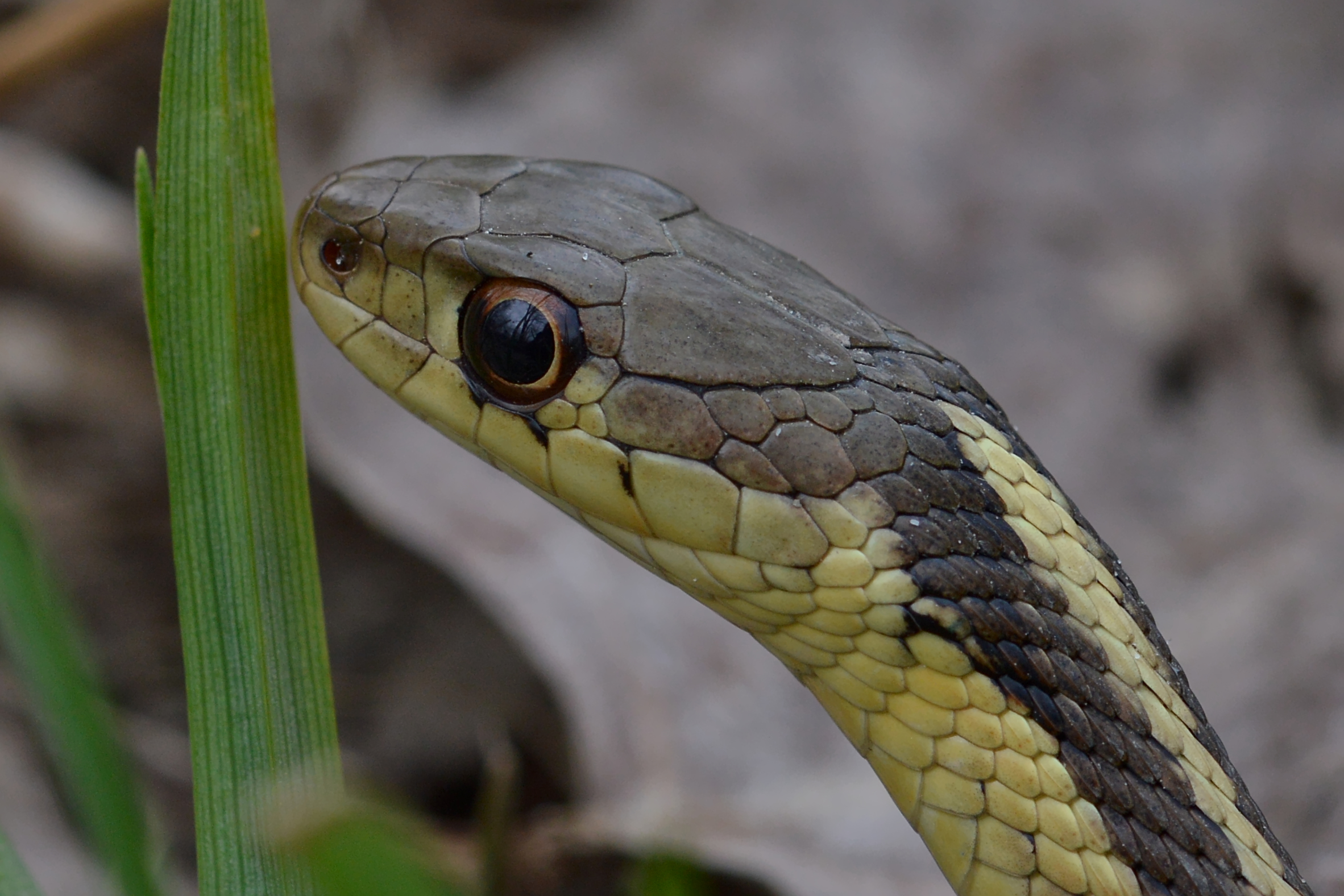We don’t see many snakes on Owl Acres, but occasionally one gets flushed from the grass, or unfortunately done in by the mower. This happened recently, much to Bryan’s chagrin. Our snakes are an active and integral part of the ecosystem, and since the snakes on Owl Acres are not harmful to humans, we hate to see them killed.
The common garter snake, (Thamnophis sirtalis) is native to North America and can be found from Quebec to Florida and west across the plains, including Owl Acres. Although they are very adaptable and can live in areas such as the arid southwest and Mexico, they prefer places like Owl Acres with nice grass cover and plenty of rain.
The common garter snake gets its name because its stripes reminded people of old-fashioned garters that men wore to hold up their socks. A greenish-yellow stripe runs down the middle of the garter snake’s back. On either side of that stripe is a black stripe which may be mottled with red or yellow. Below that on each side is another yellow stripe that merges into the color of the belly. The stripe pattern helps the snake camouflage itself. Its head is also black, and when frightened, the snake can flatten itself to make it look bigger to a predator.
Its head is triangular in shape and is wider than its neck. Its jaws are hinged so that it can swallow prey whole, and its fangs can deliver enough venom to immobilize small prey such as earthworms, small amphibians, and insects. Although the venom is not strong enough to injure a person, a garter snake’s bite can leave an itchy swelling. The snake’s teeth also point backward which helps keep prey from escaping while it’s being swallowed.
Like all snakes, garter snakes have a forked tongue. This is not for the purpose of telling lies. It is an ingenious adaptation that allows the snake to localize the source of odors. The snake flicks its tongue, catching molecules of odors. Then it carries those molecules up to the roof of its mouth where it deposits them on two corresponding specialized receptors called Jacobson’s (vomeronasal) organs. Using two reference points, one on the left and one on the right sides of the forked tongue, and analyzing the strength and direction of the scent in the corresponding receptors, the snake can very accurately pinpoint the source of the smell. We do something similar when we use both ears to localize sound.
A snake’s Scales are made of keratin, the same protein that makes hair, fingernails, and deer antlers. The garter snake’s scales are keeled—that is there’s a rigid raised line down the middle of each scale. The scales are hard and are arranged in an overlapping pattern kind of like shingles. They protect the snake’s skin and also help it move. Since snakes don’t have legs, they use their strong muscles to slither forward. The scales point toward the back, so slide freely forward but catch and keep the snake from going backward.
Garter snakes shed their skin often while they are young, but only a couple times a year when they’re mature. The process begins when they grow a new skin beneath the old one with a milky layer between. Then the snake rubs its mouth and nose on the ground until the skin begins to come off. When the opening is large enough, the snake slides out, turning the old skin inside out as it goes, rather like taking off a sweaty sock. The scales that cover a snake’s eyes come off along with the rest of the skin, and for a few days after shedding its skin, the snake is blind. It usually hides during that time until things are back to normal.
Garter snakes are very cold-tolerant. When temperatures get too low, they will often find a den and gather in a ball with dozens or even hundreds of other snakes. The ball can be as large as a basketball. They’ll overwinter in the ball, in a state of suspended animation called brumating. This is similar to hibernation, except that the snakes are not asleep. When spring comes, they will all emerge and mate in a frenzy. Then they will go their separate ways.
About four months later, a female will give birth. She has incubated her eggs internally all the while, and now delivers 30 or 40 live baby snakes. The babies are seven to nine inches long and ready to go. They don’t get any help from mom. They’re on their own. If they’re lucky, they will grow to be about two feet long and live for four to ten years. Most of them are not that lucky, which is probably just as well since if they all survived, that would amount to a lot of snakes.
Photo from Wikimedia.org by Ryan Hodnett Alt text: Head shot of a small snake that usually gets little notice. Eastern Garter Snake has alternating yellow and dark green to black stripes that run the length of its body. Its head is small and oval shaped, with large round eyes

3 comments
Very nice!!! Love snakes!
If you haven’t read “An Immense World” by Ed Yong, I’d highly recommend it! Fascinating stories about animal senses, including snake chemoreception as you discuss here.
I have the Ed Yong book, actually. Excellent!